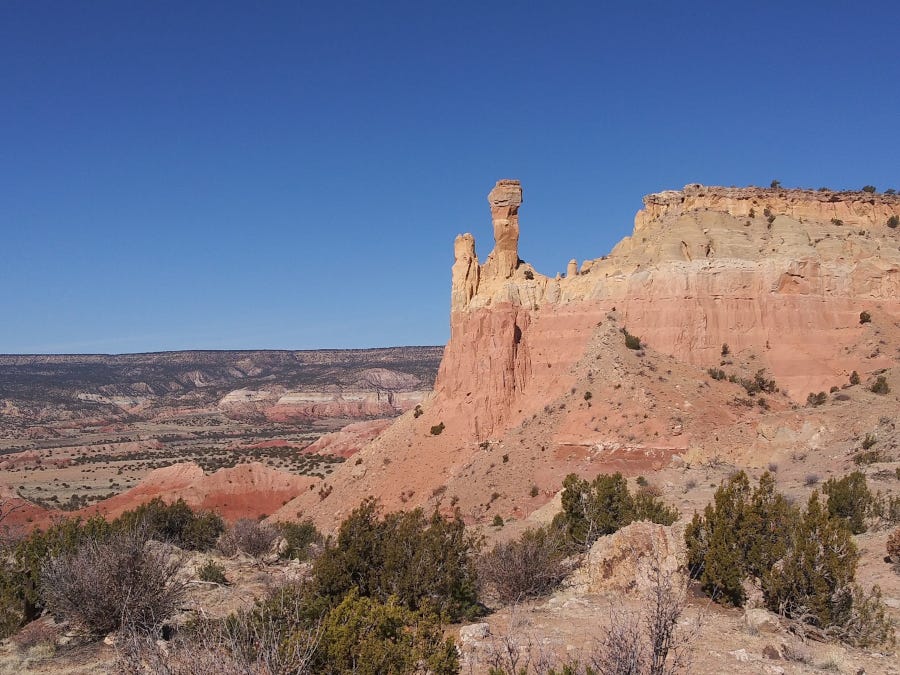A few days ago, Google Photo reminded me that a full year had passed since Kim and I were happily wandering around northern New Mexico. Hikes at Ghost Ranch, a tour of O'Keeffe's home in Abiqui, a lazy morning in the springs at Ojo Caliente, and stacked enchiladas combined to distract us from any pre-pandemic anxiety. While sipping drinks at a local beer garden we heard the news that SXSW had been canceled, ushering us towards a new reality.
Upon our return from New Mexico, still infatuated with the high desert landscape, I naively vowed to return in the fall, once the virus had run its course. To that end, I called AAA to request a copy of their Indian Country map, inappropriately named, but useful nonetheless. Maps spark the imagination, creating visions of both future and past travels. While a return to New Mexico has yet to materialize, I have revisited this map and others, scanning them to reduce bouts of home-bound claustrophobia, giving the mind space to roam.
Last night, I opened my ten-year old copy of the Rand McNally Road Atlas, its over-sized softbound format making it hard to shelve and, therefore, often close at hand. Turning the pages while tracing routes, my mind drifted. Deceptively simple in design, this atlas provides comfort, opening paths and powering the imagination. Less a tool for specific navigation, it shines as a vehicle of inspiration, absent any digital annoyances announcing the precise distance to the next bend in the road. There is an appeal of a two-dimensional tool for a multi-dimensional universe.
Much of my waking life has been spent with printed and bound materials. From early childhood trips to the library to haunting all manner of bookstores while training in librarianship and the book arts, my day-to-day has been surrounded with page counts, collation, appraisal, and the trade of volumes both common and obscure. Through it all, the Rand McNally Road Atlas remains a valued resource.
Like a fine dictionary, a home with a readily available road atlas welcomes the curious. Designed to aid in the movement of people, the road atlas also migrates thoughts and ideas. Studying a page, imagining roads not taken as well as those previously traversed, you create new worlds, noticing new connections. Old trade routes bleed through and you can trace paths of development, land grabs, and commerce. People move, spaces change, but the atlas remains inert, reflective of a specific time of creation and open to wondrous interpretations. The atlas doesn’t predict road conditions, suggest alternate routes, recommend places to eat, or talk to you. You get what you are willing to pull from it.
Of course, any atlas has its deficiencies. Regional history and local flavor is often absent or hidden. Getting off the couch and out on terra firma is essential. In the pre-pandemic days I often took walks that included short cuts through the grounds of the Austin State Hospital. There, with some wandering, you could find the old school diner, still open to the public, but largely forgotten by nearby residents. Around the corner was a relict gymnasium where one morning I spied a hospital aide with basketball and gym bag. These days the grounds are closed, with the western edge of campus undergoing major demolition in anticipation of new facilities. One afternoon I stopped to marvel at the cleared spot where just days before a slew of buildings stood. New construction was commencing while the piles of reinforced concrete rubble had been carted by the truckloads to some secret dumping location.
Where does all of this stuff go? The road atlas does not demarcate any mounds of discarded concrete. A recent walk at Onion Creek Metropolitan Park found us alone in a field full of prickly pear and retama, all sharing space with piles of discarded concrete far from any road or obvious structures. What developmental forces brought this detritus here?
A former mentor in the rare book world once plainly stated that the history of Texas is told via land use as recorded by maps. This is true and yet there remains much land use undocumented or under-represented in our maps. Wandering through the patchwork of Texas public lands can provide small glimpses into these lesser known histories. Road atlases, local maps, and travel guides rarely highlight the proverbial concrete dumps and that’s just fine by me. The unknown or unexpected, like the mesquite blossoms below, are part of the joy of exploration. As the pandemic wanes, opportunities to get off the couch will increase. The stories are out there and I look forward to more wanderings to uncover them.










I'm drooling over a map right now. Many adventures begin with a map....
Nothing sparks the imagination quite like a map. Cheers to following one soon! ✨